Far away amid the thunders of Niagara, surrounded by a perpetual rainbow, Iris Island contains almost the only known burying-place of the race of red men. Probably the simple Indians who buried their dead in a place of such difficult access, and sacred to the Great Spirit, did so from a wish that none might ever disturb their ashes. None can tell how long those interred there have slept their last long sleep, but the ruthless hands of the white men have profaned the last resting-place of the departed race.
There were also numerous blacks in the streets, and, if I might judge from the brilliant colours and good quality of their clothing, they must gain a pretty good living by their industry. A large number of these blacks and their parents were carried away from the States by one of our admirals in the war of 1812, and landed at Halifax.
The capital of Nova Scotia looks like a town of cards, nearly all the buildings being of wood. There are wooden houses, wooden churches, wooden wharfs, wooden slates, and, if there are side walks, they are of wood also. I was pleased at a distance with the appearance of two churches, one of them a Gothic edifice, but on nearer inspection I found them to be of wood, and took refuge in the substantial masonry of the really handsome Province Building and Government House. We went up to the citadel, which crowns the hill, and is composed of an agglomeration of granite walls, fosses, and casemates, mounds, ditches, barracks, and water-tanks.
If I was pleased with the familiar uniforms of the artillerymen who lounged about the barracks, I was far
